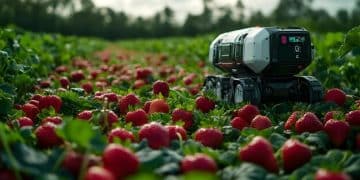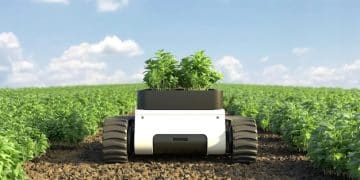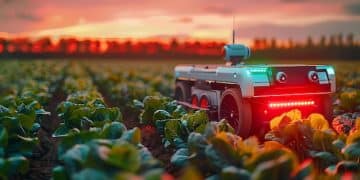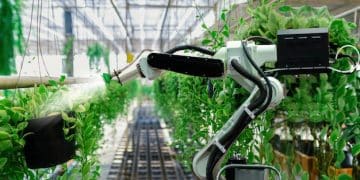Robotics in Agriculture: Autonomous Tractors Revolutionize Farming

Robotics in agriculture, particularly the use of autonomous tractors, is revolutionizing planting and harvesting processes by increasing efficiency, reducing labor costs, and improving crop yields through precision farming techniques.
The agricultural sector is undergoing a significant transformation, and at the forefront of this change is the integration of robotics in agriculture. Autonomous tractors, equipped with advanced sensors, GPS technology, and sophisticated software, are rapidly changing how crops are planted and harvested, promising increased efficiency and sustainability.
The Rise of Autonomous Tractors in Modern Agriculture
Autonomous tractors represent a new era in farming, offering solutions to many of the challenges faced by modern agriculture. These machines not only reduce the need for manual labor but also optimize various farming processes, leading to better yields and more sustainable practices.
The increasing adoption of robotics in agriculture is driven by the need for greater efficiency and precision. Let’s delve deeper into the key aspects of this technological revolution in farming.
Enhancing Efficiency and Productivity
One of the primary benefits of autonomous tractors is their ability to operate around the clock, significantly increasing productivity. Unlike human operators who require rest, these machines can work continuously, maximizing the use of available time and resources.
Precision Farming Techniques
Autonomous tractors are equipped with advanced sensors and GPS technology that enable them to perform tasks with unparalleled precision. This leads to more efficient use of resources and reduced environmental impact.
- Optimized Planting: Autonomous tractors can plant seeds at precise depths and intervals, ensuring uniform growth and maximizing yield potential.
- Targeted Irrigation: These machines can apply water only where it is needed, reducing water waste and promoting healthier plant growth.
- Precise Harvesting: Autonomous harvesting systems can identify and pick ripe crops with minimal damage, reducing losses during the harvesting process.
In summary, autonomous tractors are transforming agriculture by enhancing efficiency, improving precision, and contributing to more sustainable farming practices. These advancements are crucial for meeting the growing global demand for food.
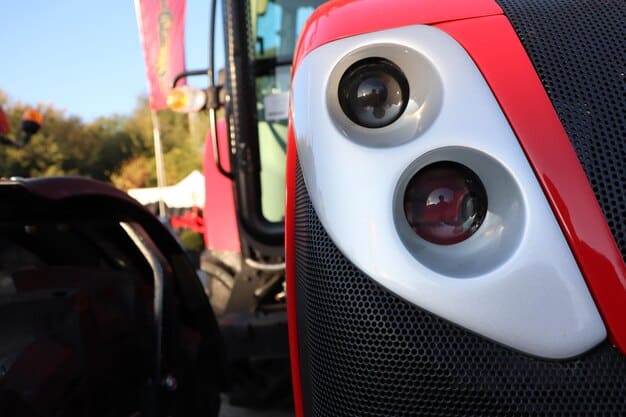
Key Benefits of Autonomous Tractors
The advantages of integrating autonomous tractors into agricultural operations are numerous and far-reaching. From reducing labor costs to promoting sustainable practices, these machines offer a range of benefits that can significantly improve the farming industry.
Let’s consider some of the most significant advantages of using autonomous tractors in agriculture.
Reduced Labor Costs
One of the most immediate benefits of autonomous tractors is the reduction in labor costs. With the ability to operate without human drivers, these machines can significantly decrease the need for farmworkers.
Improved Accuracy and Consistency
Autonomous tractors can perform tasks with greater accuracy and consistency than human operators. This leads to more uniform crop growth, reduced waste, and higher overall yields.
Sustainable Farming Practices
By optimizing resource use and reducing waste, autonomous tractors contribute to more sustainable farming practices. This includes minimizing water usage, reducing the need for pesticides, and improving soil health.
- Reduced Chemical Use: Precise application of fertilizers and pesticides minimizes chemical runoff and promotes a healthier environment.
- Optimized Water Usage: Targeted irrigation reduces water waste and ensures that crops receive the right amount of water for optimal growth.
- Improved Soil Health: Autonomous tractors can minimize soil compaction by following optimized driving patterns, which promotes better soil health and fertility.
In conclusion, the benefits of autonomous tractors extend beyond cost savings to include improvements in accuracy, consistency, and sustainability, making them an invaluable asset in modern agriculture. Their ability to optimize resource use and reduce waste contributes to more environmentally friendly farming practices.
Challenges and Considerations for Autonomous Tractor Adoption
While the potential benefits of autonomous tractors are compelling, there are several challenges and considerations that farmers must address before adopting this technology. These include initial costs, technical complexities, and regulatory hurdles.
Let’s examine some of the primary challenges associated with the adoption of autonomous tractors.
High Initial Investment
The initial cost of purchasing autonomous tractors can be a significant barrier for many farmers, particularly small and medium-sized operations. The advanced technology and specialized equipment required for these machines often come with a hefty price tag.
Technical Expertise and Maintenance
Operating and maintaining autonomous tractors requires a certain level of technical expertise. Farmers need to be trained on how to use the software, troubleshoot technical issues, and perform routine maintenance tasks.
Regulatory and Safety Concerns
The use of autonomous tractors is subject to various regulations and safety concerns. Farmers need to ensure that their operations comply with all relevant laws and guidelines, including those related to data privacy and environmental protection.
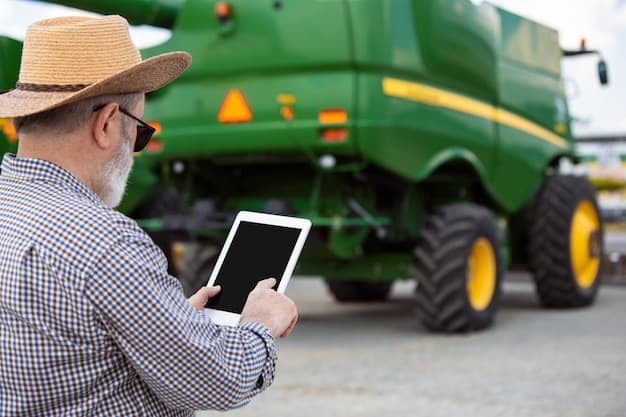
Adopting autonomous tractors involves navigating initial costs, technical complexities, and regulatory requirements. Addressing these challenges will pave the way for widespread adoption and realization of the technology’s full potential.
Impact on Crop Yields and Quality
Autonomous tractors have a profound impact on crop yields and quality, enabling farmers to optimize planting, irrigation, and harvesting processes. By delivering the right inputs at the right time and in the right amounts, these machines contribute to healthier and more productive crops.
Let’s examine how autonomous tractors improve crop yields and quality.
Optimized Planting
Autonomous tractors can plant seeds at precise depths and intervals, ensuring uniform growth and maximizing yield potential. This precision planting reduces the risk of uneven crop development and promotes healthier plants.
Efficient Irrigation
These machines can apply water only where it is needed, reducing water waste and promoting healthier plant growth. Targeted irrigation ensures that crops receive the right amount of water without overwatering or underwatering.
Precise Harvesting
Autonomous harvesting systems can identify and pick ripe crops with minimal damage, reducing losses during the harvesting process. This precision harvesting ensures that crops are harvested at the optimal time, preserving their quality and maximizing their market value.
In summary, autonomous tractors are improving crop yields and quality by optimizing planting, irrigation, and harvesting processes. Their ability to deliver precise inputs and minimize waste leads to healthier, more productive crops.
The Future of Autonomous Tractors in Agriculture
The future of autonomous tractors in agriculture looks promising, with ongoing advancements in technology and increasing adoption rates. As these machines become more sophisticated and affordable, they are poised to play an even greater role in shaping the future of farming.
Let’s explore the potential developments and future applications of autonomous tractors in agriculture.
Advancements in Technology
Ongoing research and development efforts are focused on improving the capabilities of autonomous tractors. This includes enhancing their sensor systems, improving their navigation algorithms, and integrating them with other advanced technologies such as artificial intelligence and machine learning.
Integration with Other Farming Technologies
Autonomous tractors are increasingly being integrated with other farming technologies, such as drones and data analytics platforms. This integration enables farmers to gather and analyze data from multiple sources, providing them with valuable insights that can inform their decision-making.
- Drone Integration: Drones can be used to monitor crop health and identify areas that require attention, allowing autonomous tractors to target their efforts more effectively.
- Data Analytics: Data analytics platforms can be used to analyze data collected by autonomous tractors, providing farmers with insights into soil conditions, crop growth patterns, and other factors that can impact yield potential.
- AI and Machine Learning: AI and machine learning algorithms can be used to optimize the performance of autonomous tractors, adapting their behavior based on real-time conditions and historical data.
Autonomous tractors will likely become more sophisticated, integrated with other technologies, and widely adopted in the future. These developments will enable farmers to enhance efficiency, reduce costs, and promote sustainable farming practices, further revolutionizing agriculture.
Case Studies: Successful Implementation of Autonomous Tractors
Several case studies highlight the successful implementation of autonomous tractors in various agricultural settings. These examples demonstrate the potential of this technology to improve efficiency, reduce costs, and enhance sustainability.
Let’s examine some of these successful implementations.
Case Study 1: Precision Planting in Corn Fields
A study conducted in the Midwest region of the United States demonstrated that using autonomous tractors for precision planting in corn fields resulted in a 15% increase in yield compared to traditional planting methods. The autonomous tractors were able to plant seeds at precise depths and intervals, ensuring uniform growth and maximizing yield potential.
Case Study 2: Efficient Irrigation in Vineyards
A vineyard in California implemented autonomous tractors to manage irrigation, resulting in a 20% reduction in water usage and a 10% increase in grape quality. The autonomous tractors were equipped with sensors that monitored soil moisture levels and applied water only where it was needed, reducing water waste and promoting healthier plant growth.
Case Study 3: Autonomous Harvesting in Apple Orchards
An apple orchard in Washington State used autonomous harvesting systems to pick ripe apples with minimal damage, resulting in a 12% reduction in losses during the harvesting process. The autonomous harvesting systems were able to identify and pick ripe apples at the optimal time, preserving their quality and maximizing their market value.
These case studies show the effectiveness of autonomous tractors improving efficiency, reducing costs, and enhancing sustainability across different agricultural settings. The success stories underline the potential of this technology to revolutionize farming practices.
| Key Point | Brief Description |
|---|---|
| 🚜 Efficiency Increase | Continuous operation maximizes productivity. |
| 💰 Cost Reduction | Automation lowers labor and resource costs. |
| 🌱 Sustainable Practices | Optimized resource use minimizes environmental impact. |
| 📈 Yield Improvement | Precision farming leads to higher crop yields and quality. |
Frequently Asked Questions (FAQ)
▼
Autonomous tractors are agricultural vehicles that operate without human drivers, using advanced sensors, GPS technology, and sophisticated software to perform tasks such as planting, harvesting, and irrigation.
▼
Autonomous tractors can operate around the clock, maximizing the use of available time and resources. They also perform tasks with greater accuracy and consistency than human operators, leading to higher productivity.
▼
The challenges include the high initial investment, the need for technical expertise and maintenance, and regulatory and safety concerns. Farmers need to address these issues before adopting this technology.
▼
By optimizing resource use and reducing waste, autonomous tractors contribute to more sustainable farming practices. This includes minimizing water usage, reducing the need for pesticides, and improving soil health.
▼
The future looks promising, with ongoing advancements in technology and increasing adoption rates. Autonomous tractors are poised to play an even greater role in shaping the future of farming by enhancing efficiency and promoting sustainability.
Conclusion
In conclusion, the integration of robotics, particularly autonomous tractors, is revolutionizing agriculture by enhancing efficiency, reducing labor costs, and promoting sustainable practices. While challenges exist, the benefits of increased crop yields, improved quality, and optimized resource use make autonomous tractors a key component of the future of farming.
